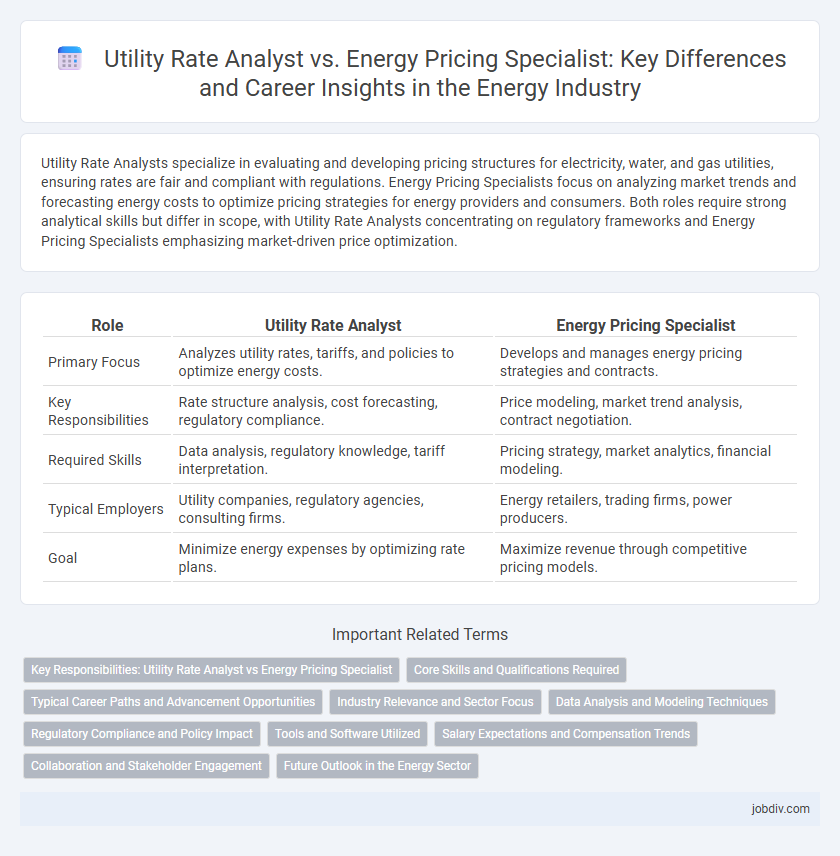Utility Rate Analysts specialize in evaluating and developing pricing structures for electricity, water, and gas utilities, ensuring rates are fair and compliant with regulations. Energy Pricing Specialists focus on analyzing market trends and forecasting energy costs to optimize pricing strategies for energy providers and consumers. Both roles require strong analytical skills but differ in scope, with Utility Rate Analysts concentrating on regulatory frameworks and Energy Pricing Specialists emphasizing market-driven price optimization.
Table of Comparison
| Role | Utility Rate Analyst | Energy Pricing Specialist |
|---|---|---|
| Primary Focus | Analyzes utility rates, tariffs, and policies to optimize energy costs. | Develops and manages energy pricing strategies and contracts. |
| Key Responsibilities | Rate structure analysis, cost forecasting, regulatory compliance. | Price modeling, market trend analysis, contract negotiation. |
| Required Skills | Data analysis, regulatory knowledge, tariff interpretation. | Pricing strategy, market analytics, financial modeling. |
| Typical Employers | Utility companies, regulatory agencies, consulting firms. | Energy retailers, trading firms, power producers. |
| Goal | Minimize energy expenses by optimizing rate plans. | Maximize revenue through competitive pricing models. |
Key Responsibilities: Utility Rate Analyst vs Energy Pricing Specialist
Utility Rate Analysts focus on analyzing and interpreting utility rate structures, conducting cost-of-service studies, and providing rate design recommendations to ensure regulatory compliance and optimize customer billing. Energy Pricing Specialists develop pricing models, forecast market trends, and design competitive energy pricing strategies that align with company goals and market conditions. Both roles require expertise in energy economics, regulatory environments, and data analysis to support strategic decision-making in the energy sector.
Core Skills and Qualifications Required
Utility Rate Analysts require strong analytical skills, expertise in utility tariff structures, regulatory compliance knowledge, and proficiency in data modeling and financial analysis. Energy Pricing Specialists must possess deep understanding of market pricing mechanisms, risk management, and forecasting techniques, along with experience using energy trading platforms and statistical software. Both roles demand excellent communication abilities and a solid foundation in economics or energy management to optimize energy procurement and cost strategies.
Typical Career Paths and Advancement Opportunities
Utility Rate Analysts often begin their careers in regulatory agencies or utility companies, progressing to senior analyst or managerial roles by specializing in rate design and regulatory compliance. Energy Pricing Specialists typically advance through positions in energy trading firms or consultancy, leveraging expertise in market dynamics and pricing models to move into strategic planning or executive roles. Both career paths offer upward mobility through continued specialization in energy markets, regulatory frameworks, and advanced data analytics.
Industry Relevance and Sector Focus
Utility Rate Analysts specialize in evaluating and designing rate structures for electric, gas, and water utilities, playing a critical role in regulatory compliance and tariff optimization within the public utility sector. Energy Pricing Specialists concentrate on market-driven pricing strategies for electricity, natural gas, and renewable energy, focusing on competitive energy markets and corporate energy procurement. Both roles require deep industry knowledge; however, Utility Rate Analysts are more aligned with public utilities and regulatory bodies, while Energy Pricing Specialists are pivotal in energy trading firms, independent power producers, and large energy consumers.
Data Analysis and Modeling Techniques
Utility Rate Analysts specialize in evaluating utility tariffs and regulatory impacts using statistical software and forecasting models to optimize energy costs for consumers. Energy Pricing Specialists focus on market trends and competitive pricing strategies through advanced data modeling techniques like regression analysis and machine learning algorithms to predict price fluctuations. Both roles rely heavily on data analysis but differ in their primary focus: regulatory rate structures versus market-driven pricing dynamics.
Regulatory Compliance and Policy Impact
Utility Rate Analysts specialize in evaluating and interpreting tariff structures, ensuring utility companies comply with regulatory frameworks set by public utility commissions and other governing bodies. Energy Pricing Specialists focus on developing pricing models that reflect market trends while integrating regulatory policies, directly influencing energy market competitiveness and customer rate stability. Both roles require deep knowledge of federal and state energy regulations to navigate policy impacts and support strategic decision-making within utility companies.
Tools and Software Utilized
Utility Rate Analysts primarily use spreadsheet software like Microsoft Excel and specialized rate analysis tools such as RatePro and EnergyCAP to model and evaluate utility tariffs. Energy Pricing Specialists often rely on advanced pricing software platforms including Lean Energy Insight and Pragma Energy pricing suite, incorporating market data analytics and real-time energy trading systems. Both roles leverage Geographic Information System (GIS) tools and predictive analytics software to optimize pricing strategies and rate structures efficiently.
Salary Expectations and Compensation Trends
Utility Rate Analysts typically earn between $60,000 and $90,000 annually, influenced by experience and geographic location, while Energy Pricing Specialists command a higher range from $75,000 to $110,000 due to specialized expertise in market trends and tariff structures. Compensation trends show increasing valuation of data analytics skills and regulatory knowledge, driving salary growth in both roles within energy sectors. Salary benchmarks also reflect demand fluctuations tied to renewable energy integration and evolving utility rate frameworks.
Collaboration and Stakeholder Engagement
Utility Rate Analysts collaborate closely with regulatory bodies, utility companies, and internal finance teams to ensure accurate rate structures align with market regulations and customer needs. Energy Pricing Specialists engage with market analysts, sales teams, and energy traders to develop dynamic pricing models that reflect real-time market conditions and demand fluctuations. Both roles require strong stakeholder engagement skills to balance technical analysis with strategic communication, facilitating informed decision-making and effective energy cost management.
Future Outlook in the Energy Sector
Utility Rate Analysts will see growing demand as regulatory environments evolve, requiring expertise in tariff structures and compliance to support sustainable energy initiatives. Energy Pricing Specialists are expected to play a critical role in managing volatile energy markets by leveraging advanced analytics and forecasting models to optimize pricing strategies. Both roles will be essential in driving innovation and cost-efficiency amid the transition to renewable energy and decentralized power systems.
Utility Rate Analyst vs Energy Pricing Specialist Infographic

 jobdiv.com
jobdiv.com